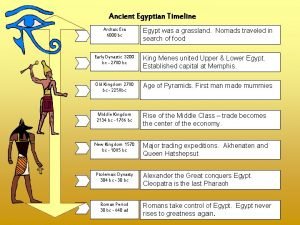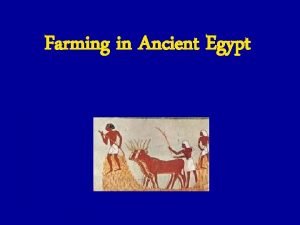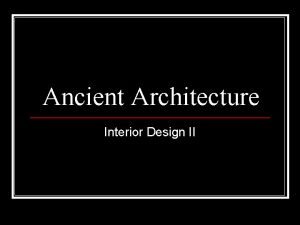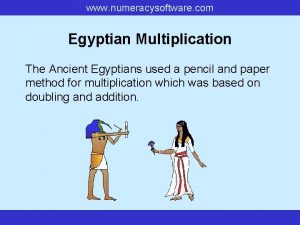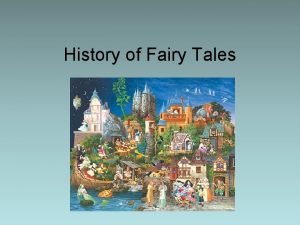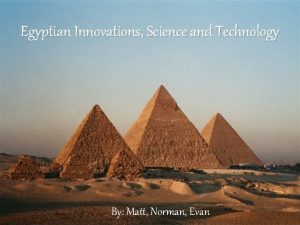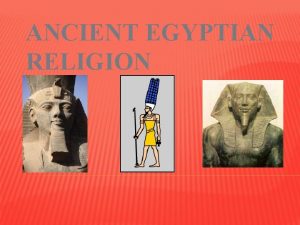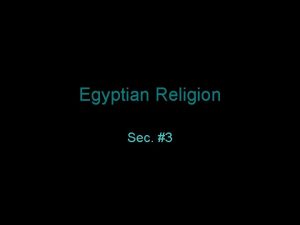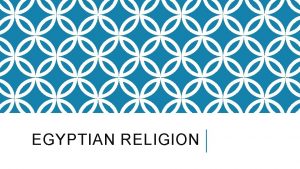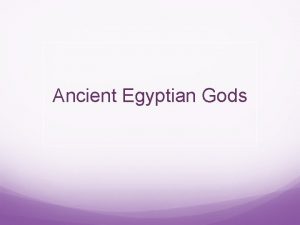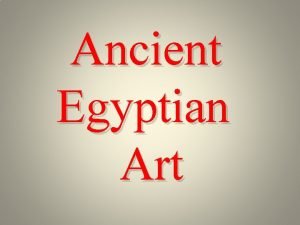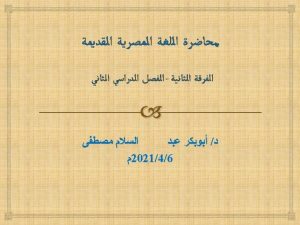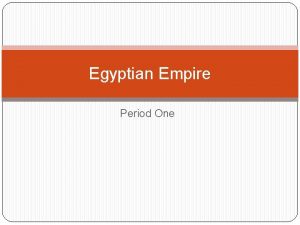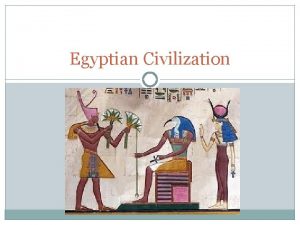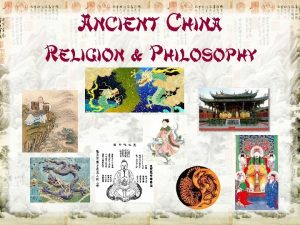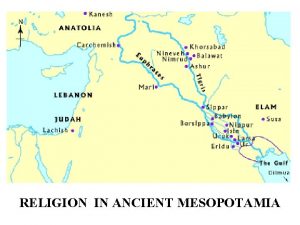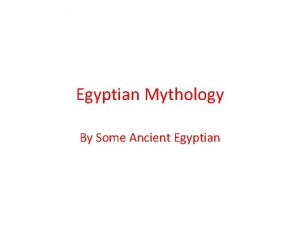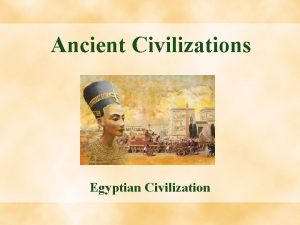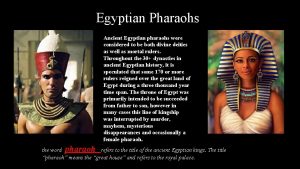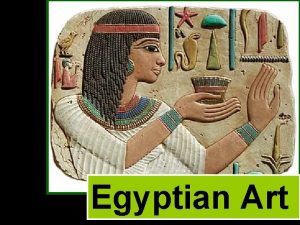Ancient Egyptian Religion Chapter 5 Things to know




















- Slides: 20

Ancient Egyptian Religion Chapter 5

Things to know… �Religion provided the Egyptians with a sense of security. �They had no word for religion �Religious ideas represented an inseparable part of the entire world order �Invented stories to explain the world around them �They were polytheistic �Definition – belief in many gods �Egyptians hoped to gain new life after death.

When we try to make some sense out of the many Egyptian gods and goddesses, we must keep in mind that because ancient Egyptian civilization existed for more than three thousand years, the deities and myths gradually changed over time as a result of new ideas, contact with other peoples, and changing cultural values.

�Egyptian gods were also thought of as characters in human-like bodies, but often with animal heads. �Paintings were discovered on caves of priests wearing animal masks.

�Gods were connected to animals. They believed that immortal spirits inhabited the bodies of animals. They hoped that by pleasing the spirit with their prayers, it would provide them with plenty of animals for the hunt. They also prayed to dangerous animals to keep themselves safe.

The Power of the Sun - Ra (Re) �Ra (Re), the sun god, is pictured with the falcon-head of Horus and the sun disk and the sacred serpent �Ra had been the main sun god of Egypt since as far back as the Old Kingdom. �He is the most important deity because he creates life and death. Egyptians knew this because the sun gave life and could take it away.

Belief in an Afterlife �They believed, like crops, people could return to life �Death viewed as a beginning, not an end. �Everyday Ra was reborn in the morning, traveled across the sky in his boat, then traveled to the Land of the Dead when the sun set �His journey symbolized life, death, and rebirth.

Myth of Osiris �Explains the miracle of rebirth �Osiris’s evil brother, Seth tricked him into getting into a chest, then threw it into the Nile. Isis and her sister found it. �Seth then cut Osiris into 14 pieces and threw them into the Nile. Isis gathered the pieces and took them to the Anubis, who wrapped them in linen and restored Osiris to life.

Anubis – god of mummies �Jackal-headed god responsible for the processes of embalming and the protection of cemeteries. �He guided the deceased through the underworld which entailed a special judgment ceremony called "The Weighing of the Heart" which determined whether or not the person could go on to Osiris. �If the heart is heavy with sin, it is thrown to Ammut!

Ammut �Head of a crocodile, mane and front legs of a lion, and hindquarters of a hippo. �It was believed that when a person died, the soul had to pass through a dangerous underworld known as Duat where it faced all sorts of dangers like monsters and lakes of fire. If the heart is heavy with sin, it is thrown to Ammut, "the devourer of the dead, " who gobbles it up, denying the spirit an afterlife and causing it to cease to exist!

Isis �Queen of the gods. �Both sister and wife of Osiris, mother of Horus and the daughter of Nut and Geb. �Goddess of fertility and motherhood, love and gaiety, and she had magical skills. �Also goddess of the harvest

Who’s who among deities: �NUT – Goddess of the sky �GEB – God of the earth �SETH – God of violence. Evil brother of Osiris �HORUS – Son of Osiris and Isis; defeated his evil Uncle Seth and became the king of Egypt �BASTET – Spirit of the cat, symbolized by this goddess was called “miu” �HAPI – God of the Nile’s flooding cycle and

The Power of Ma’at �State of perfect harmony �Also the name for the goddess, depicted with outstretched wings �When Ma’at was upheld Egypt prospered – the Nile flooded normally, enough crops were produced, and invaders stayed out �If Ma’at was disturbed, there was a return to Chaos

Vocabulary � SCARAB BEETLE – This insect became a symbol of regeneration and rebirth. Placing one of these in a tomb helped the person achieve an afterlife � EYE OF HORUS – Symbol of good health

Vocabulary � ANKH– Egyptian symbol for eternal life

Vocabulary � AMULETS – Small statues of the gods worn around the neck to bring luck � APIS – Sacred bull in the temple of Ptah, said to have magic and medicinal powers.

So Many Deities! �Remember, the Egyptians didn’t eliminate old beliefs when they added something new. �Some gods, like Osiris and Ra were worshipped by everyone �Others were regional �Taweret – goddess of childbirth �Bes – god of pleasure �Meretseger – worshipped to prevent snakebites

Priest • Had the power to communicate with the gods and interpret messages for the people. • Priesthood was passed down from father to son • Pharaoh was the highest priest • Greatest legacy was passing down reading and writing to the next generation

Typical Day of a Priest… �Awakens the gods by singing and burning incense �Takes old robes off the statue and puts new ones on �Offers the god food and wine. The statue receives three meals a day �Statue gets a fresh robe at night �Priest bathes four times and shaves twice during the day �Sweeps floor of sanctuary and backs out

Amonhotep IV • Pharaoh who tried to change Egypt’s religion from polytheistic (worshipping many gods) to monotheistic (worshipping one god) • The one god was the sun god, Aten, who was the creative force of the universe • He changed his name to Akhenaten, which means “pleasing to Aten” • Wife was the beautiful Nefertiti
 Ancient egyptian floral arrangements
Ancient egyptian floral arrangements Where did the pharaoh live
Where did the pharaoh live Egyptian religion timeline
Egyptian religion timeline Egyptian kalasiris
Egyptian kalasiris Ancient egypt transportation
Ancient egypt transportation Early american period floral design
Early american period floral design What crops did the egyptian farmers grow
What crops did the egyptian farmers grow Ancient egypt social pyramid
Ancient egypt social pyramid Ancient egyptian interior design
Ancient egyptian interior design Frontalism definition
Frontalism definition Ancient egyptian toothbrush
Ancient egyptian toothbrush Ancient egyptian slaves
Ancient egyptian slaves Ancient egyptian method of multiplication
Ancient egyptian method of multiplication Ancient egyptian commoner clothing
Ancient egyptian commoner clothing Image
Image Ancient egyptian technology
Ancient egyptian technology Egyptian mythology
Egyptian mythology Western religion vs eastern religion
Western religion vs eastern religion Know history know self
Know history know self Do deep generative models know what they don’t know?
Do deep generative models know what they don’t know? He is a friend of mine the god of angel armies
He is a friend of mine the god of angel armies


